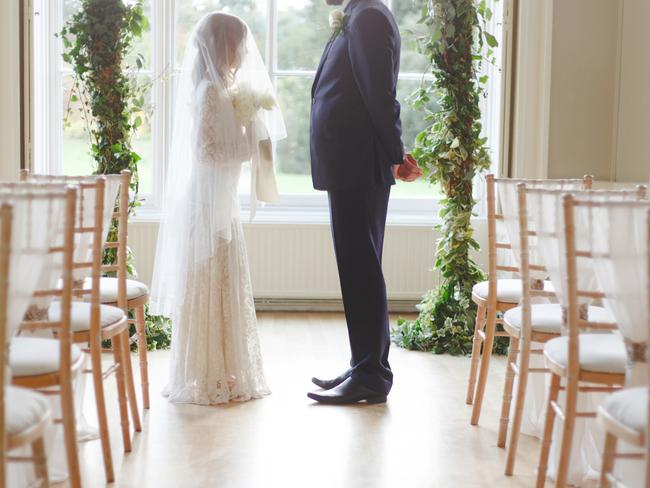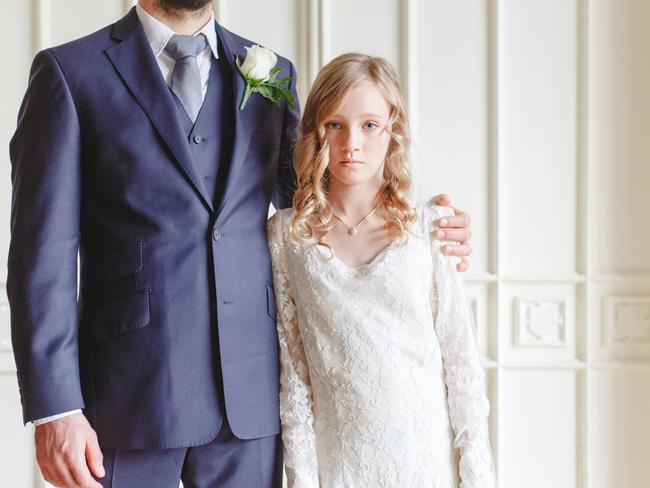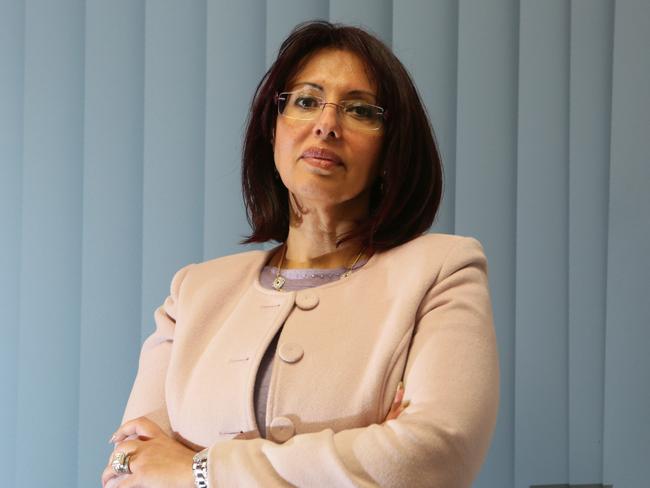Most girls at risk of being married against their will are ‘falling through the gaps’
FORCED and child marriage in Australia is increasing, and most girls and young women at risk are missing out on help.

VIC News
Don't miss out on the headlines from VIC News. Followed categories will be added to My News.
THE girls sitting around the communal dining table looked relaxed and well cared-for. Long-haired, beautiful and young, they seemed quite at home chatting over koftas, salads and chopped fruit.
It was not until I had left the refuge I visited in a secret Melbourne location to interview young women for another story that I was told who these unassuming girls were — young women fleeing forced marriage.
It is quite possible people are looking for those girls; their safety is so tenuous a long-time manager/worker campaigned to get even the refuge’s name off the agency’s website.
Though mainly a service provider, the organisation has worked with the Australian Federal Police to help at least two Australian citizens be repatriated after being sent overseas to marry against their will.
“I’ve had girls here who I don’t think understand what the repercussions are (for them),” says the worker, whose name we have chosen not to reveal so as not to identify the shelter. “They’re going to have to be careful of their safety and security just about forever. They can’t go to certain places because members of their family or community may be there; it is really a very dangerous situation for them. They can be killed, that’s the threat.”
These girls face a terrible choice. To be referred to the government-funded program targeted at forced marriage victims or those at risk, and helped to find safe long-term shelter and potentially start a new life, they need to instigate charges on their families by the AFP under Australia’s 2013 human trafficking laws.
If police are notified, a young person can receive ongoing housing, counselling, legal, financial and other support. If not, within three months they are back out on their own.
Bernadette Marantelli, youth support manager for Melbourne’s Centre for Multicultural Youth, has also worked with Victorian girls facing forced marriage. Among them were sisters aged 16 and 17, who were due to be flown overseas to marry.
The girls did not want to be identified to authorities (many are scared of consequences and do not wish to leave their families), making support through the government-funded Support for Trafficked People system difficult.
They were helped with accommodation but the father “systematically put pressure” on them and eventually both were taken to Pakistan and married. The case illustrates the dilemma for young people under the current charges or nothing system.

“If children choose not to pursue charges there are no service systems in place at all; all but one (that she knows of) have been returned home and married off,” Marantelli says. “If your decision is not to press charges, beyond three months there is no support. There isn’t any automatic response unless the young person (goes ahead with charges); what we are asking of these disempowered, vulnerable young women is inappropriate. Family and community is all they have; they are being asked to make a decision which could mean never returning home.”
Before the 2013 laws, the AFP had investigated only three cases of forced or child marriage. In 2015-16 the figures more than doubled — from 33 in 2014-15 to a reported 69.
Just last week, prominent Muslim cleric Ibrahim Omerdic, 61, appeared in the Melbourne Magistrates’ Court charged with conducting a wedding ceremony between a
girl, aged under 16, and a man in his 30s. It was alleged in court that in the days after the wedding last year, the girl was raped by her husband. The husband, who cannot be named, is currently behind bars on remand after being charged with sexual penetration of a child under 16 and forcing the girl into marriage.
The co-ordinator of the Support for Trafficked People program, the Red Cross’s Helen Seignior, says it has dealt with around 26 cases in the past two years. The majority were “young female teenagers, aged 15-17, who are really looking for help, needing to leave because they are under the threat of being forced to marry”.
Given many of these girls have led sheltered lives in loving, if traditional families, according to workers including Good Shepherd Australia and New Zealand’s Dr Kathy Landvogt many struggle to know how to find help.
“It is embedded in a child from birth who they will marry.”
The subject is still so cloaked in secrecy, even agencies willing to speak for this article would not assist Weekend to speak directly with girls at risk. Because there is no dedicated forced marriage hotline or freely accessible support service for girls to seek targeted support — or for their teachers, doctors or others who may identify signs — and due to legal action being the only trigger for systemic support, “the majority” of young people facing forced marriage “fall through the gaps”, according to Good Shepherd Australia.
Landvogt says girls are usually reluctant to go to the police and don’t want to leave families.
If victims call the general family violence hotline, 1800RESPECT, the most common place to receive forced marriage calls for help, they still eventually need to be interviewed by the Australian Federal Police to get into the Red Cross program.
Agencies say they are not satisfied the Federal Government understands the need for a more comprehensive response.
“We would like to see the service gap acknowledged and evidence of a more systematic response,” says Dr Landvogt, whose organisation jointly founded the Victorian Forced Marriage Network two years ago with multicultural welfare groups.
She stresses the difference between arranged marriage, which is legal so long as both parties are old enough and offer informed consent, and forced marriage. A forced marriage is one in which either party cannot or does not give consent, or has not freely and fully consented because they have been coerced, threatened, intimidated, deceived or pressured.
Agencies consider the figure of 69 potential recent cases the tip of the iceberg.
Though some immigrant women’s services did not wish to comment, Melba Marginson, executive director of the Victorian Immigrant and Refugee Women’s Coalition, has said her network sees 150 women a week, most of whom come from communities where forced marriages are practised.
The National Children’s and Youth Law Centre has said it identified 250 cases of under-age marriage in 2012-14.

According to UNICEF 15 million girls will become child brides this year, married before age 18. Worldwide there are more than 700 million women who were married as children, more than one in three of whom were married younger than 15. UNICEF has wide international support for its global program to help eliminate child marriage by 2030.
The issue impacts young people from a diverse range of backgrounds including African, South-East Asian and Middle Eastern.
New South Wales has taken far more decisive action on forced marriage than Victoria. In September, NSW Family and Community Services Minister Brad Hazzard warned “a tsunami of young girls, some as young as nine” are being taken overseas and forced to marry.
Unlike Victoria, NSW releases detailed information and though, according to Good Shepherd, careful handling of the issue is necessary to keep it from going further underground, Hazzard warned communities “this is Australia you are living in and you must acknowledge our laws and protect our children”.
Advocates stress forced and under-age marriage is a human rights issue. It is also discussed as a form of family violence.
Given it is now widely known that forced and under-age marriage is illegal, many youth advocates argue there needs to be more action.
On 2016’s World Day of Social Justice, Good Shepherd called for a dedicated service system for forced marriage victims, a national forced marriage hotline and the inclusion of forced marriage in respectful relationships education.
Women’s rights advocate Dr Eman Sharobeem endured a violent, 14-year marriage after being forced to wed a cousin in Egypt.
A long-time director of the Immigrant Women’s Health Service in western Sydney, she doubts more funding for awareness-raising would do much good and suggests communities need to be helped to manage the issue.

She believes girls at risk would be unlikely to know about Anti Slavery Australia’s federally funded website My Blue Sky.
Late last year Sharobeem called on religious leaders to educate their communities that the practice is unacceptable, and says the most effective way to prevent a forced or child marriage is for respected people within the community to manage it with the family.
She says refuges cannot meet demand for beds for young people fleeing forced marriage.
“From the day I started to speak about forced marriage and child brides five years ago my aim wasn’t to attract funding for a website, or to criminalise parents and imprison fathers,” Sharobeem says. “Please do not race for resources; empower the front line to be able to understand the symptoms and be vigilant.”
Many advocates do not believe teachers and school counsellors are well enough trained about what to look for or how to help.
Sharobeem has intervened in cases of forced marriage to negotiate solutions with families and says most girls would not even speak to her unless she guaranteed not to go to authorities.
“Girls want to go back to their homes, they want to continue to be girls and treated with care,” she says.
“We need to develop an education program that is highly sensitive to different cultures. It needs to be flexible and organic … we have a good opportunity to educate communities when new migrants come to Australia. This is a group we can talk to and keep educating for the first five years of residency.”
Betul Tuna, a Shepparton youth worker and member of the city’s Ethnic Council, campaigns local communities to abandon forced marriage and female genital mutilation. She knows of huge financial and emotional pressure put on girls from a very young age to coerce them into being ready for the marriage their parents want.
She says some parents aware child marriage is illegal get around trafficking laws by arranging for “children with no say to be engaged very young, but they are flexible (with marriage age) so they don’t commit a crime”.

“It is embedded in a child from birth who they will marry. There is a lot of financial burden on it — we bought this, we did this for them, lots of ceremonies to kind of pretty it up,” Tuna says. “We’ve seen families forcing kids and you’ve got kids yelling and screaming and saying ‘no’, but they do end up caving in and marrying; caving in to all the pressure.”
She is highly critical of the piecemeal way in which the issue is being addressed by a federal government reluctant to “open a can of worms no one wants opened”.
“I want to know how (the government via legislation) is going to protect my daughter or my son if something happens to me … I want to know the government is protecting my children regardless of my religion.
“My religion (Islam) says nothing is more important than protecting the health of children; I’m doing what my religion is telling me to do. If I stay quiet, I am part of the abuse.”
For help, contact: mybluesky.org.au/get-help/I-am-in-a-forced-marriage/
CALL 1800RESPECT FOR CRISIS SUPPORT
RESEARCH TO FILL IN GAPS
GOOD Shepherd is appealing to the community for donations to support a national research project into forced marriage.
The project will identify gaps in services across Australia for girls and young women who are vulnerable to forced marriage, and develop and trial resources for organisations to support staff to better help forced marriage victims and those at risk.
Donations will help build a better support system to improve outcomes for young women and girls.
Visit goodshep.org.au or call 9270 9700.


